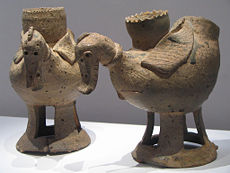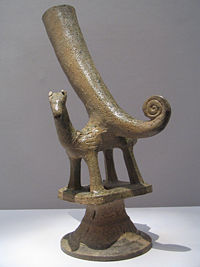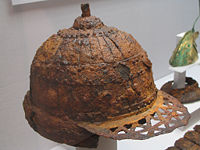Gaya confederacy
| Gaya confederacy | ||||||||
|---|---|---|---|---|---|---|---|---|
 Duck-shaped pottery from Gaya, 5th or 6th century. | ||||||||
| Korean name | ||||||||
|
Gaya was a confederacy of chiefdoms in the Nakdong River valley of southern Korea, growing out of the Byeonhan confederacy of the Samhan period. It was ultimately absorbed into Silla, one of the Three Kingdoms of Korea.
Names
Although most commonly referred to as Gaya (가야; 加耶, 伽耶, 伽倻), due to the imprecision of transcribing Korean words into hanja, historical sources use a variety of names, including Kaya, Garak (가락; 駕洛, 迦落), Gara (가라; 加羅, 伽羅, 迦羅, 柯羅), Garyang (가량;加良), and Guya (구야; 狗耶).
History
|
Jeulmun Period
|
According to a legend recorded in the Samguk Yusa, in the year 42 C.E., six eggs descended from the heaven with message that they would be kings. Six boys were born, and within 12 days they grew mature. One of them, named Suro, became the king of Geumgwan Gaya, and the other five founded the other five Gayas, namely Daegaya, Seongsan Gaya, Ara Gaya, Goryeong Gaya, and Sogaya.
Gaya arose from the twelve tribes of the ancient Byeonhan, one of the Samhan confederacies. The loosely organized chiefdoms resolved into six Gaya groups, centered around Geumgwan Gaya. On the basis of archeological sources as well as limited written records, scholars such as Cheol (2000) have identified the late 3rd century as a period of transition from Byeonhan to Gaya, with increasing military activity and changing funerary customs. Cheol (2000) further argues that this was associated with the replacement of the previous elite in some principalities (including Daegaya) by elements from Buyeo, who brought a more militaristic style of rule.
Economy

Situated around the mouth of the Nakdong River, an area with fertile plains, access to the sea, and rich iron deposits, Gaya had an economy based on agriculture and fishing as well as trade. It was particularly known for its ironworking, as Byeonhan had been before it. Gaya exported abundant quantities of iron armor and weaponry to Baekje and the Kingdom of Wa in Yamato period Japan. In contrast to the largely commercial and non-political ties of Byeonhan, Gaya seems to have attempted to maintain strong political ties with these kingdoms as well.
Politics
Different records list different chiefdoms of Gaya. Goryeo Saryak (고려사략; 高麗史略) lists five: Geumgwan Gaya, Goryeong Gaya, Bihwa Gaya, Ara Gaya, and Seongsan Gaya.
The various Gaya mini-states formed a confederacy in the 2nd and 3rd centuries, centered around Geumgwan Gaya in modern Gimhae. Ong Gwang Gobuon, which are estimated to have been build in the 2nd century,were found near Naju, Muan, Hampyeong, and Yeon-an. in After a period of decline, the confederacy was revived around the turn of the 5th and 6th centuries, this time centred around Daegaya of modern Goryeong, but it was unable to defend itself for long against Silla and Baekje. Daegaya was the last to fall, conquered by Silla in 562. [1]
Gaya had close relations with the Wa of northern Kyushu in Japan, during that nation's formative years. The nature of the relationship between the Wa and Gaya has been a matter of extensive controversy, mostly fueled by Japanese revisionist historians. The Nihonshoki claims that Gaya (named "Mimana" also "Kara" in Japanese) was a colony or tributary of Wa. In World War II, the Japanese used this supposed historic link between Kyushu and Gaya as justification for colonization.
Some Korean scholars believe that Wa may have been a colony or tributary of Baekje. Archaeological evidence suggests that Gaya was the main exporter of technology and culture to Kyushu at this time.[2]
Today, most scholars regardless of nationality believe that the relationship between Gaya and Wa was close, but not colonial. The argument that "Japan conquered the southern tip of the peninsula where it established a 'colony' called Mimana have since been largely discounted by historians in both Japan and Korea."[3]
Gallery
See also
- List of Korea-related topics
- History of Korea
- List of Korean monarchs#Gaya_confederacy
- Three Kingdoms of Korea
- Crown of Gaya
- Gaya - Silla Wars
ReferencesISBN links support NWE through referral fees
Cheol, S.K. (2000). Relations between Kaya and Wa in the third to fourth centuries AD. Journal of East Asian Archeology 2(3-4), 112-122.
Credits
New World Encyclopedia writers and editors rewrote and completed the Wikipedia article in accordance with New World Encyclopedia standards. This article abides by terms of the Creative Commons CC-by-sa 3.0 License (CC-by-sa), which may be used and disseminated with proper attribution. Credit is due under the terms of this license that can reference both the New World Encyclopedia contributors and the selfless volunteer contributors of the Wikimedia Foundation. To cite this article click here for a list of acceptable citing formats.The history of earlier contributions by wikipedians is accessible to researchers here:
The history of this article since it was imported to New World Encyclopedia:
Note: Some restrictions may apply to use of individual images which are separately licensed.


